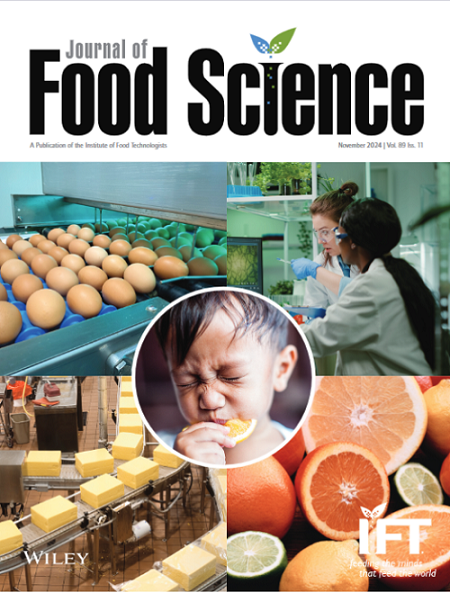A novel active biopolymer coating of pectin, potato starch, and pyrogallol: Impact on postharvest quality of tomato (Solanum lycopersicum L.)
Abstract
Recently, there has been an increasing interest in biodegradable films for extending food's shelf life. This study developed pectin–potato starch-based films incorporating varying pyrogallol concentrations and evaluated shelf life their physical, antioxidant, mechanical, optical, antibacterial, structural, biodegradation, and shelf-life properties. Among the tested films (F1, pectin; F2, pectin + potato starch; F3, pectin + potato starch + 0.5%pyrogallol; and F4, pectin + potato starch + 1%pyrogallol), F4 exhibited superior antibacterial activity against Staphylococcus aureus (42 mm), Klebsiella pneumoniae (20.5 mm), and Escherichia coli (25.5 mm), antioxidant activity (AA) (95% (diphenylpicrylhydrazyl), 76% (metal chelating activity), and 87% (hydroxyl radical scavenging assay)), mechanical, and soil biodegradation. Fourier transform infrared spectroscopy and field emission scanning electron microscopy confirmed biocompatibility, whereas differential scanning calorimetry studies showed thermal stability. Shelf-life studies on tomatoes at 30°C demonstrated that F4 film coating extended shelf life to 21 days by reducing weight loss (14.5%), total phenolic content (25 mg/100 g), AA (53.5%), firmness (46 N), and titratable acidity (0.38%) while maintaining the total soluble solids, pH, lycopene content, color, and microbial inhibition. This study introduces a novel active biodegradable film with enhanced antimicrobial, mechanical, and antioxidant properties for sustainable food packaging applications.
Practical Application
This study introduces an eco-friendly biopolymer coating formulated to extend the shelf life of food by reducing spoilage and maintaining quality during storage. The coating is cost-effective, easy to produce, and can be used for industrial-scale applications by giving a sustainable alternative to synthetic packaging. It can provide consumers with long-lasting produce by maintaining freshness, reducing food waste, and promoting environmentally conscious food preservation practices.


 求助内容:
求助内容: 应助结果提醒方式:
应助结果提醒方式:


